A six percent rise in wholesale value, eight percent more producers, and an increase of 12 percent in acreage. The report card for U.S. floriculture is looking pretty good, when comparing 2018 to the situation three years earlier (see the Floriculture Crops 2018 Summary from the USDA National Agricultural Statistics Service). So things are looking up for growers in the U.S., but will it remain that way? And what are the challenges and opportunities the industry can expect to see in the near future?
More domestic cultivation
Debra Prinzing is the founder of Slow Flowers, a community-based branding and media campaign that advocates for the floral industry and its consumers to embrace local, seasonal, and sustainable flowers. She's noticing not only an increase in the amount of domestic growers, but also more interest in the Slow Flowers Movement. "We have continued to experience audience and participation growth in all channels. The term 'slow flowers' is more widely recognized than ever before. In the four years since we began subscribing to Keyhole.co, an independent tracking service, #slowflowers has generated more than 160 million social media impressions (June 2015 to present). Wikipedia published an entry about Slow Flowers in April 2019, reflecting a new level of mainstream popularity for the concept of domestic and sustainable floriculture."
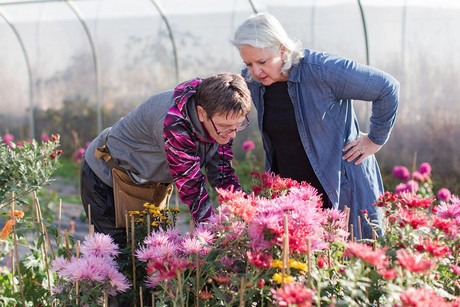
Debra Prinzing visiting Vivian Larson of Everyday Flowers in Stanwood, Wash.
Debra believes that the beauty and romance of domestic flowers will continue to woo those in the wedding and event marketplace, as demand for unique, ephemeral and hard-to-ship floral options is fueled by social media. "Imported flowers are the backbone of the US floral marketplace, but the role played by domestic and locally-grown botanicals is undeniable. What is changing in the Slow Flowers community is a continuance of floral entrepreneurship among key regional players. The proliferation of cooperative marketing ventures, collectives between flower farmers and floral designers, and hyper-regional hubs for selling local flowers is changing the definition of 'wholesale.' The new farmer-to-florist enterprises are flying under the radar and finding creative and innovative ways to satisfy demand for seasonal and local botanicals - and this is happening across the U.S. in large and smaller markets."
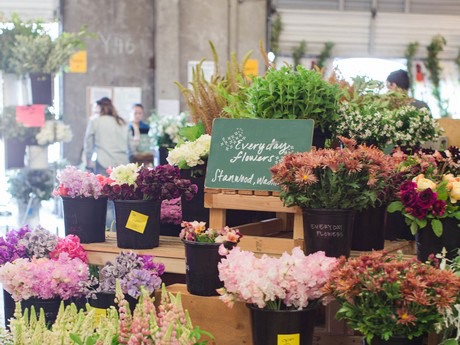
The Seattle Wholesale Growers Market is a farmer-owned cooperative that sells farm-to-florist. Credit: Missy Palacol Photography
Jennie Love, President of the Association of Specialty Cut Flower Growers (ASCFG) is also the owner of Love ‘n Fresh Flowers. Her flower farm, established in 2008, is currently in a state of rapid expansion. Jennie agrees that there has been a clear increase in awareness of the value of sustainable floral design and of seeking out locally-grown blooms. "More customers are asking about the origin of the bouquets they are buying. There is also a tremendous increase in small flower farms in the United States, typically under five acres and often started by individuals who have not had previous farming experience but are drawn to the beauty and creativity that flowers offer. The surge of 'farmer-florists' in particular is notable." This is reflected in the number of ASCFG members, which reached an all-time high in 2019, averaging nearly 50 new members a month.
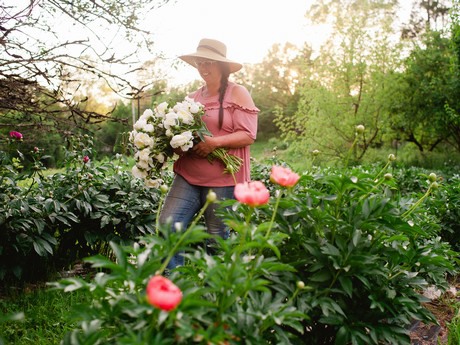
Jennie Love at the farm
Interest from suppliers
Judy Laushman, Executive Director of the Association of Specialty Cut Flower Growers, notes an increased interest in the ASCFG from industry suppliers. “Representatives of several seed companies have recently joined the organization, and have asked to participate in our National Seed Trials”.
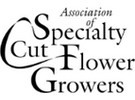 The ASCFG sponsors yearly evaluations of field and greenhouse annuals, herbaceous perennials, bulbs, and woody plants for cut flower production. Cultivars new to the industry are submitted by U.S. and international suppliers, and are grown, harvested, and evaluated by growers across North America. This information is valuable to the breeders, suppliers, and commercial cut flower growers. Find out more in this paper co-authored by Judy.
The ASCFG sponsors yearly evaluations of field and greenhouse annuals, herbaceous perennials, bulbs, and woody plants for cut flower production. Cultivars new to the industry are submitted by U.S. and international suppliers, and are grown, harvested, and evaluated by growers across North America. This information is valuable to the breeders, suppliers, and commercial cut flower growers. Find out more in this paper co-authored by Judy.
In it together
While customer awareness of "locally-grown" has risen, this increase in small farm operations can also cause an increase in competition, Jennie notes. "Several metropolitan markets, including my own in Philadelphia, are beginning to experience saturation. This market saturation is leading to struggles with keeping prices fair and sustainable. No doubt these growing pains will all shake out in time. At the moment, there are many reasons to be excited about the future for locally-grown flowers and the floral industry as a whole in the U.S., but there are also a few reasons to be concerned. Professional education for both growers and floral designers is critical at this time to keep the industry healthy."
Like Debra, Jennie also foresees an increase in cooperative selling to enable small growers to grab more market share in the wholesale sector. "I anticipate small 'boutique' wholesalers run by forward-thinking designer cooperatives and/or grower cooperatives will become common in most major metropolitan areas in our country. Time will only tell if this model will be sustainable and profitable."
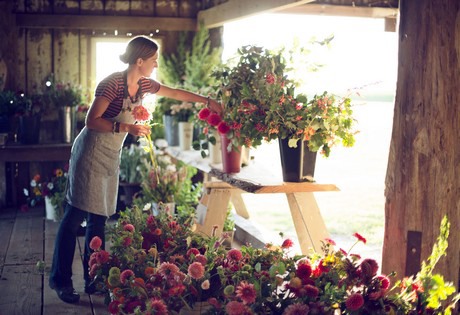
Erin Benzakein (Floret Flower Farm). Photography: Lara Dart
Erin Benzakein, founder of Floret Flower Farm, also points to the entry of many small flower farms and small scale specialty growers supplying local flowers directly to florists and consumers as one of the highlights of the past year. She sees florists, farmers, and event designers continuing to offer locally-sourced flowers on a much wider scale than today. "I predict that we’ll continue to see more regional collaboration among growers and continued growth and diversification of sales via partnerships with other local businesses seeking locally-grown products. I think Instagram and other forms of social media will continue to act as powerful tools for fostering connections between growers and designers and their customer bases."
'Tis the season...
In most of the U.S., many flower types are seasonal—spring, summer, and fall—and local flowers aren't available in the winter without a greenhouse. The challenge then is how to keep customers interested in buying local but handle the idea that selection will be limited in the winter, according to Dr. John Dole, Professor of Horticulture, and Associate Dean & Director, Academic Programs, North Carolina State University, Raleigh.
"Many of our farmer/florists do a great job of blending local and purchased flowers and I think they can handle the reduced selection during the winter easier by buying flowers but also incorporating their own woody stems, foliages, and dried materials. It is harder for growers who sell at markets, specialty grocery stores and the wholesalers to have local material in the winter."
Jamie Rohda of Harvest Home Flowers agrees. "I think a big challenge facing growers now is being able to keep up with the demand. I feel like we’ve created excitement for locally grown flowers but keeping up with the demand, especially in the off season, may be difficult", she says.
So how should flower growers deal with this? "The answer may be to celebrate the seasonality of many flowers and encourage our customers to really enjoy them when they are available. Many of the big food chains have turned the idea of seasonality into a marketing bonanza ('limited time only...')", John suggests.
A different kind of flower
Flower cultivation is flourishing in the States, but recently, other crops have gained some territory, most notably cannabis. Debra points to the continued shift to non-floriculture crops among large-scale commercial cut flower farms as one of the challenges in the near future. "I don't have first-hand knowledge of this, but I'm sure you've seen the reporting. In my opinion, the silver lining to the dynamic changes among large commercial growers, most of which are California-based, is that locally-grown flowers in all states and all markets become a more necessary and relevant option for customers."
Ko Klaver, President and CEO of Botanical Trading Company, agrees with that sentiment. "The challenges currently are the shift that growers are making from flowers to hemp, cannabis and indoor produce production. These changes take space away from the square footage of flower growing, but ultimately it should be reflecting in an upward pricing on our flower products at a wholesale and ultimately the retail level."
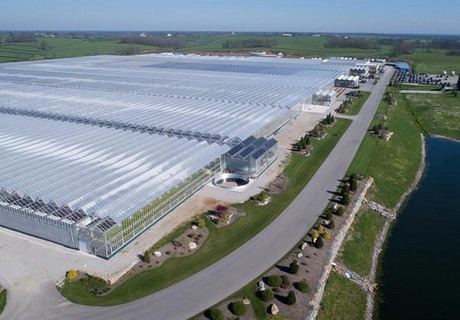
ColorPoint, one of the biggest bedding plant growers in the United States, announced in May that the company would make the switch to hemp.
The labor climate
In 2018, the average peak number of hired workers employed on operations was 19, according to the Floriculture Crops 2018 Summary. Overall, 69 percent of operations used some hired labor during 2018. While this is a decrease of 6 percent compared to 2015, the majority of growers is still impacted by issues in the labor market.
"Many growers have been dealing with a labor shortage these last two years, the minimum wages are constantly going up, and then there are the challenges that come with employing a migrant labor work force", Ko explains. "This does mean that growers will have to look at efficiencies, regarding automatization and mechanizing their workflow, and review their production output, which means most likely investing more in equipment."
Debra also sees labor as a major challenge, while also pointing to transportation and climate change. "Climate/weather disruptions are happening it seems all across North America," she says, giving two examples of recent weather events American growers had to deal with:
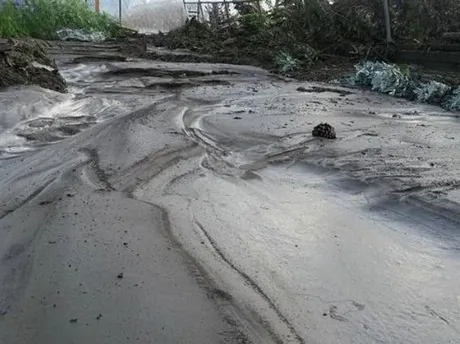
In 2018, Mountain Belle Flower Farm was hit by mudslides.
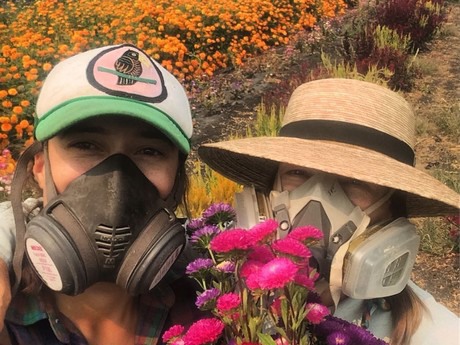
Wildfire season in Southern Oregon with Isabella Thorndike Church of Jacklily Floral and her mother, Joan Thorndike, owner of Le Mera Gardens in Ashland, Oregon
Erin Benzakein agrees. The lows this year, she says, "have mostly been related to extreme weather events and dealing with the very real impacts of our changing climate." For the coming year, she expects "some of the biggest challenges will continue to be related to climate change and extreme weather events."
Weather has also been a challenge for the team at Alaska Perfect Peony, according to Rita Jo Shoultz, who also is the current chair of the board at Certified American Grown. That group was the major instigator in lobbying for the USDA-NASS to be back after missing several years of data reporting. The American flower farmers went to Washington, D.C. to lobby hard to have the USDA Floriculture Report re-instated and for States like Alaska to be included in the report.
"We broke all records for heat. Instead of a 4-week cutting period everything happened in about 10 days. Of course this caused challenges in overflowing coolers etc.", Rita Jo shares. They're looking for a great year in 2020 though. "We've taken steps to assure our cold chain is perfect even if there's another warm summer".
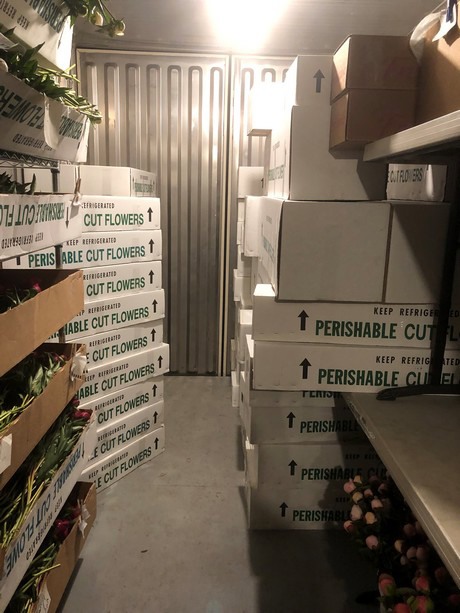
Peonies in cold storage at Alaska Perfect Peony
Other growers, like Jamie Rohda of Harvest Home Flowers in Waverly, Nebraska, and Val Schirmer of Three Toads Farm in Winchester, Kentucky, also indicate they've been dealing with weather extremes this year: record-breaking temperatures and drought in some parts of the country, with devastating floods in others.
Reaching the consumer
For the future, Debra sees increasing innovations in moving locally-grown flowers from rural micro farms to urban floral customers, pointing to two models that illustrate these innovations:
- Farms are attracting customers to come directly to them with on-farm retail, flash sales, pop-up experiences and special events.
- Farms are combining resources as collectives and cooperatives to move flowers to customers, through establishing their own wholesale locations, developing shared delivery routes, and finding unique partnerships with conventional wholesale operations willing to "host" their vendors.
Val Schirmer of Three Toads Farm sees this as one of the biggest challenges for the American flower industry in 2020: to continue to differentiate itself from cheaper imports. "We need to continue to talk about local flowers to our customers and to the media, and help our flower farmers and farmer-florists understand and be able to easily and consistently talk about it."
Erin also sees great opportunities for growers to build customer loyalty and reach new audiences via flower-focused events, educational opportunities, and other creative on-farm experiences. Her upcoming book, A Year in Flowers, which explores creative ways to incorporate homegrown and seasonal flowers into everyday life, is a good example of this kind of original marketing.
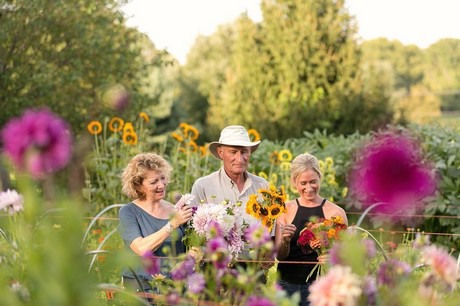
The 'three Toads' of Three Toads Farm. Credit: Melanie Mauer
In addition to more local sales, Ko also notices that consumers are buying more and more online. "The biggest challenge will be how the logistics of that buying process have come into play in many angles of our industry. Ultimately it is the consumer voting with their wallet, they are looking for the best quality flowers, for a decent price and with the most convenient way to get it in their hands."
